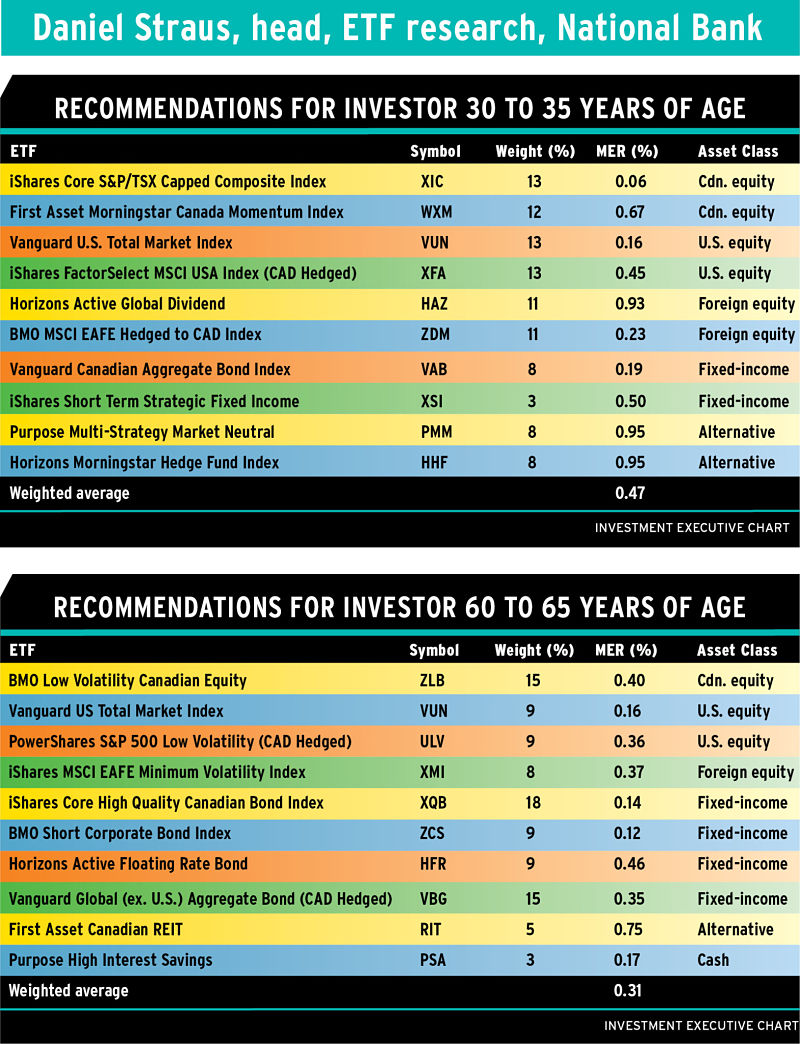
The abundance of choice in the Canadian-listed, exchange-traded fund (ETF) market makes constructing portfolios with globally diversified exposure to a variety of asset classes possible by using only ETFs.
Investment Executive asked two ETF analysts in Toronto, Daniel Straus, head of ETF research and strategy at National Bank Financial Ltd., and Yves Rebetez, managing director and editor at research and consulting firm ETF Insight Inc., to build model portfolios to suit two imaginary investors.
Investor A is young and upwardly mobile, 30 to 35 years of age. He or she is working and has potential for career advancement. This investor is a long way from drawing retirement income from investments, and the goals are strong growth and reasonable risk for many years to come.
Investor B is a pre-retiree, 60 to 65 years old, who is still working, but has only a few years left to work and little chance of promotion. This investor’s goals are capital preservation and some growth. Investment income is not required yet, but soon will be. This investor is more risk-averse, as income-earning years are limited and there would be less time to recover from portfolio losses.
Both investors want geographical diversification and multi-class asset allocation. Although Investor A is in position to withstand more volatility than Investor B, who has a shorter time horizon, both investors want to avoid gut-wrenching drops in their portfolio’s value.
One of the major differentiators among the recommendations for the younger Investor A vs the older Investor B is the size of the allocation to fixed-income investments, which are more stable than equities, but currently offer anemic returns due to low interest rates.
Straus, for example, gives the younger, growth-oriented Investor A an 11% exposure to fixed-income, while giving the older, more conservative Investor B 51%.
Rebetez gives Investor A 20% fixed-income exposure, and Investor B gets 35%. “Given the nature of the younger investor, bonds are significantly de-emphasized in light of their insignificant yield and inferior growth prospects over time,” Rebetez says.
Neither investor has a particularly high fixed-income exposure because, as Rebetez points out, this asset category’s returns barely cover inflation.
“The main reason to have any fixed-income is so the portfolio doesn’t get completely devastated when equities markets get hammered,” he adds.
On the equities side, Straus weights the younger Investor A’s portfolio at 73% of assets, while the older Investor B gets 41%. Both investors have exposure to Canadian, U.S. and global equities, but the older Investor B has more in lower-volatility products. “With longer lifespans, even the older investor needs growth,” says Straus. “Fixed-income provides ballast, but it’s important to have growth in the other assets.”
Rebetez gives the younger Investor A 67.5% equities exposure, while the older Investor B gets a still substantial 60% to cover what could be many years of life ahead. Investor A has higher exposure to emerging markets (including China), but the emphasis for both investors in this geographical region is on high-dividend/low-volatility investment products.
“Emerging markets are inherently more volatile and dangerous, and the low volatility focus dampens the risk side of the equation,” Rebetez says. “These ETFs concentrate on the higher-quality, less levered companies.”
Both analysts have added “alternative” assets to the portfolios of both investors for enhanced growth potential. These products typically are non-correlated to traditional fixed-income and equities markets, and smooth out overall portfolio volatility.
In the alternative category, Rebetez includes 5% exposure to gold bullion for both investor types. “Gold is held partly as a quasi-cash substitute without the negative interest rate risk – gold may, in fact, be boosted by that prospect,” Rebetez says. “To the extent that negative interest rates in some countries may be interpreted as desperate measures, that also could be positive for gold as a volatility buffer.”
Rebetez also gives the younger Investor A exposure to two alternative ETFs that may use hedging strategies.
Straus gives the younger Investor A two alternative ETFs using hedging strategies, while the older Investor B’s portfolio uses only an income-oriented real estate investment trust ETF for exposure in the alternative category.
© 2016 Investment Executive. All rights reserved.